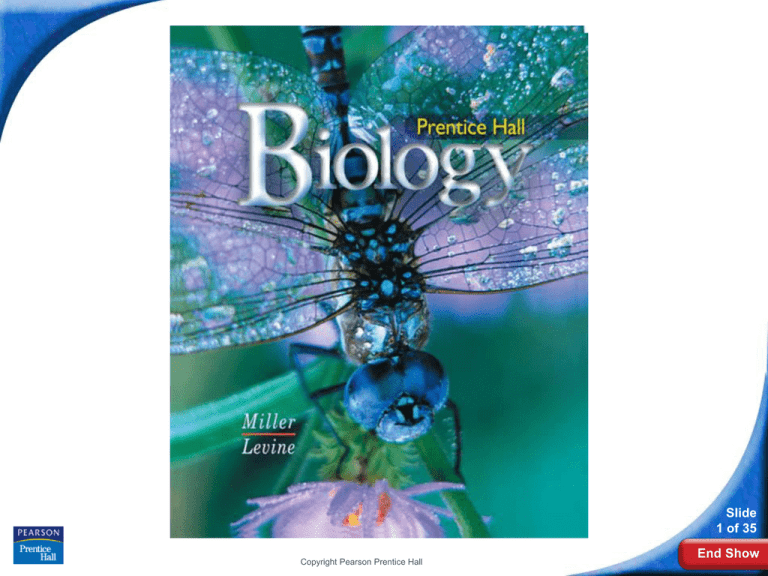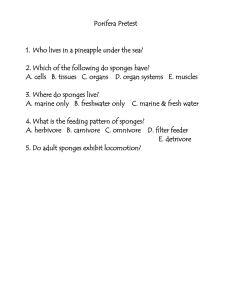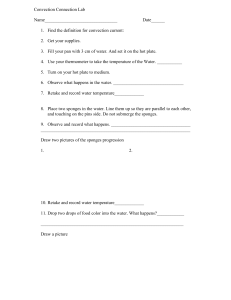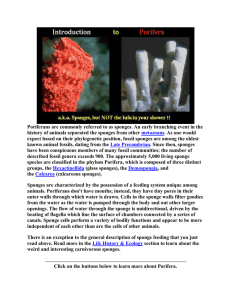Biology Slide 1 of 35 End Show
advertisement

Biology Slide 1 of 35 Copyright Pearson Prentice Hall End Show 26-2 Sponges Slide 2 of 35 Copyright Pearson Prentice Hall End Show 26-2 Sponges What is a Sponge? What is a Sponge? Sponges are in the phylum Porifera which means “pore-bearers.” Sponges live their entire adult life attached to a single spot. Slide 3 of 35 Copyright Pearson Prentice Hall End Show 26-2 Sponges What is a Sponge? Sponges are classified as animals because they are : • multicellular • heterotrophic • have no cell walls • contain a few specialized cells Slide 4 of 35 Copyright Pearson Prentice Hall End Show 26-2 Sponges Form and Function in Sponges Form and Function in Sponges Sponges do not have a mouth or gut, and they have no tissues or organ systems. Slide 5 of 35 Copyright Pearson Prentice Hall End Show 26-2 Sponges Form and Function in Sponges Body Plan Sponges are asymmetrical; they have no front or back ends, no left or right sides. Slide 6 of 35 Copyright Pearson Prentice Hall End Show 26-2 Sponges Form and Function in Sponges The body of a sponge forms a wall around a large central cavity through which water is circulated continually. Central cavity Slide 7 of 35 Copyright Pearson Prentice Hall End Show 26-2 Sponges Form and Function in Sponges Water flow Water enters through pores located in the body wall and leaves through the osculum, a large hole at the top of the sponge. Osculum Pores Slide 8 of 35 Copyright Pearson Prentice Hall End Show 26-2 Sponges Form and Function in Sponges Choanocyte Choanocytes are specialized cells that use flagella to move a steady current of water through the sponge. Pore Slide 9 of 35 Copyright Pearson Prentice Hall End Show 26-2 Sponges Form and Function in Sponges A spicule is a spikeshaped structure made of calcium carbonate or silica. Spicules are made by archaeocytes, which are specialized cells that move around within the walls of the sponge. Spicule Slide 10 of 35 End Show 26-2 Sponges Form and Function in Sponges Feeding Sponges are filter feeders. As water moves through the sponge, food particles are trapped and engulfed by choanocytes that line the body cavity. Slide 11 of 35 Copyright Pearson Prentice Hall End Show 26-2 Sponges Form and Function in Sponges Reproduction Sponges can reproduce sexually or asexually. The eggs are fertilized inside the sponge’s body, in a process called internal fertilization. Slide 12 of 35 Copyright Pearson Prentice Hall End Show 26-2 Sponges Ecology of Sponges Ecology of Sponges Sponges are important in aquatic ecology. They provide habitats for marine animals such as snails, sea stars, and shrimp. Slide 13 of 35 Copyright Pearson Prentice Hall End Show 26-2 Click to Launch: Continue to: - or - Slide 14 of 35 End Show Copyright Pearson Prentice Hall 26-2 In sponges, a spike-shaped structure made of chalklike calcium carbonate or glasslike silica is a(an) a. spicule. b. archaeocyte. c. choanocyte. d. epidermal cell. Slide 15 of 35 End Show Copyright Pearson Prentice Hall 26-2 An immature stage of an organism that looks different from the adult form is a(an) a. gemmule. b. larva. c. archaeocyte. d. choanocyte. Slide 16 of 35 End Show Copyright Pearson Prentice Hall 26-2 Specialized cells that use flagella to move water through the sponge are a. gemmules. b. pores. c. spicules. d. choanocytes. Slide 17 of 35 End Show Copyright Pearson Prentice Hall 26-2 Sponges are a. detritivores. b. carnivores. c. filter feeders. d. herbivores. Slide 18 of 35 End Show Copyright Pearson Prentice Hall 26-2 Sponges can reproduce a. sexually only. b. asexually only. c. both sexually and asexually. d. by metamorphosis. Slide 19 of 35 End Show Copyright Pearson Prentice Hall END OF SECTION




